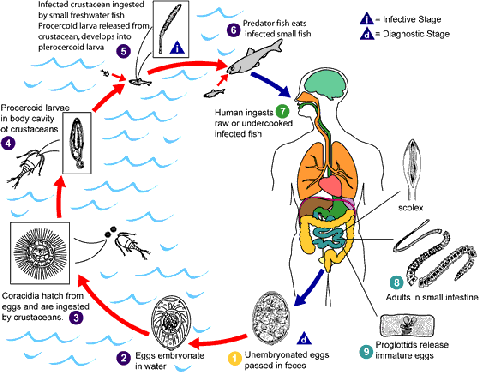The fish tapeworm is a broad, long worm, often growing to lengths of 3-7 feet at maturity and capable of attaining 30 feet. It is the longest tapeworm invading humans with as many as 4,000 segments (proglottids). The main body of the worm is virtually filled with male and female reproductive organs allowing it to produce an incredible number of eggs, often more than 1,000,000 a day. The adult attaches to the wall of the intestine with the aid of two sucking grooves located in its head (scolex).
This tapeworm is sometimes called a broad fish tapeworm, because the reproductive segments are usually broader than they are long. The adult is ivory or grayish-yellow in color and can live in humans for 20 years. Humans are the final host of this worm, but first it must pass through a tiny freshwater crustacean, and then to a fish. The larva that infects people, a 'plerocercoid', is frequently found in the intestines of freshwater and marine fish. It is sometimes found in the flesh of freshwater fish or in fish that are migrating from salt waters to fresh water for breeding.
You can be infected by eating raw, lightly cooked, under-processed freshwater or certain migratory species of salmon, perch, pike, pickerel, and turbot. The popularity of eating raw fish dishes, such as Japanese sushi and sashimi, helps to spread this disease. Cooks who sample their fish dishes before they are properly cooked put themselves at risk of being infected. Fish tapeworms are found wherever humans, bears, and other fish-eating mammals defecate in the same lakes and streams from which this fish are obtained.
Most infected people do not produce any symptoms. During the acute stage of disease, which has its onset about 10 days after eating raw or insufficiently cooked fish, the symptoms may be similar to other tapeworm infections. This includes symptoms such as diarrhea, abdominal discomfort and pain, flatulence, vomiting, nausea, and weakness. Chronic infestations may produce some of the same symptoms or only vague discomforts including fullness in the upper abdomen, water retention, loss of weight, and malnutrition. Some people are constantly hungry because the tapeworms are eating most of the food. There are times when the worm gets so large that it will cause a colon blockage. In some people a severe anemia may develop, because of this tapeworm's ability to consume most of its host's vitamin B12. Folate may be reduced as well. With the anemia that results, neurological symptoms can manifest including numbness, loss of vibration sense, and even some eye symptoms.
Life Cycle Diagram (Courtesy of the DPD)

Immature eggs are passed in feces
 .
Under appropriate conditions, the eggs mature (approximately 18 to 20 days)
.
Under appropriate conditions, the eggs mature (approximately 18 to 20 days)
 and yield oncospheres which develop into a coracidia
and yield oncospheres which develop into a coracidia
 . After ingestion by a suitable freshwater crustacean (the copepod first intermediate host) the coracidia develop into procercoid larvae
. After ingestion by a suitable freshwater crustacean (the copepod first intermediate host) the coracidia develop into procercoid larvae
 . Following ingestion of the copepod by a suitable second intermediate host, typically minnows and other small freshwater fish,
the procercoid larvae are released from the crustacean and migrate into the fish flesh where they develop into a plerocercoid larvae (sparganum)
. Following ingestion of the copepod by a suitable second intermediate host, typically minnows and other small freshwater fish,
the procercoid larvae are released from the crustacean and migrate into the fish flesh where they develop into a plerocercoid larvae (sparganum)
 . The plerocercoid larvae are the infective stage for humans. Because humans do not generally eat undercooked minnows and similar
small freshwater fish, these do not represent an important source of infection. Nevertheless, these small second intermediate hosts can be eaten by larger
predator species, e.g., trout, perch, walleyed pike
. The plerocercoid larvae are the infective stage for humans. Because humans do not generally eat undercooked minnows and similar
small freshwater fish, these do not represent an important source of infection. Nevertheless, these small second intermediate hosts can be eaten by larger
predator species, e.g., trout, perch, walleyed pike  . In this case, the sparganum can migrate to the musculature of the larger
predator fish and humans can acquire the disease by eating these later intermediate infected host fish raw or undercooked
. In this case, the sparganum can migrate to the musculature of the larger
predator fish and humans can acquire the disease by eating these later intermediate infected host fish raw or undercooked
 .
After ingestion of the infected fish, the plerocercoid develop into immature adults and then into mature adult tapeworms which will reside in the small intestine.
The adults of D. latum attach to the intestinal mucosa by means of the two bilateral groves (bothria) of their scolex
.
After ingestion of the infected fish, the plerocercoid develop into immature adults and then into mature adult tapeworms which will reside in the small intestine.
The adults of D. latum attach to the intestinal mucosa by means of the two bilateral groves (bothria) of their scolex
 . The adults can reach more than 10 m in length, with more than 3,000 proglottids. Immature eggs are discharged from the
proglottids (up to 1,000,000 eggs per day per worm)
. The adults can reach more than 10 m in length, with more than 3,000 proglottids. Immature eggs are discharged from the
proglottids (up to 1,000,000 eggs per day per worm)  and are passed in the feces
and are passed in the feces
 . Eggs appear in the feces 5 to 6 weeks after infection. In addition to humans, many other mammals can also
serve as definitive hosts for D. latum.
. Eggs appear in the feces 5 to 6 weeks after infection. In addition to humans, many other mammals can also
serve as definitive hosts for D. latum.

